Top Ten Animals a Jaguar Should Fight
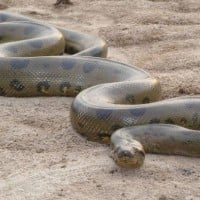 Anacondas are group of large snakes of the genus Eunectes. They are large snakes found in tropical South America.
Anacondas are group of large snakes of the genus Eunectes. They are large snakes found in tropical South America. If the jag is inexperienced, the anaconda crushes it. However, if one of the jag's first hunting lessons involves catching a small constrictor snake, it should be able to kill the anaconda.
Caimans and anacondas are a jaguar's food.
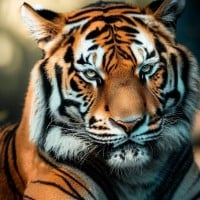 The tiger (Panthera tigris) is the largest living cat species and a member of the genus Panthera. It is most recognisable for its dark vertical stripes on orange fur with a white underside. An apex predator, it primarily preys on ungulates such as deer and wild boar. It is territorial and generally a solitary but social predator, requiring large contiguous areas of habitat, which support its requirements for prey and rearing of its offspring. Tiger cubs stay with their mother for about two years, then become independent and leave their mother's home range to establish their own. ...read more.
The tiger (Panthera tigris) is the largest living cat species and a member of the genus Panthera. It is most recognisable for its dark vertical stripes on orange fur with a white underside. An apex predator, it primarily preys on ungulates such as deer and wild boar. It is territorial and generally a solitary but social predator, requiring large contiguous areas of habitat, which support its requirements for prey and rearing of its offspring. Tiger cubs stay with their mother for about two years, then become independent and leave their mother's home range to establish their own. ...read more. Tiger would kill the jaguar easily
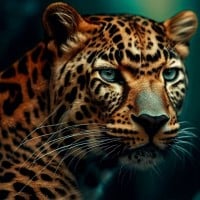 The leopard is one of the five "big cats" in the genus Panthera. It is one of the most adaptable and the most widespread big cat; it's secrets being:well camouflaged fur; its opportunistic hunting behaviour, broad diet, and strength to move heavy carcasses into trees; its ability to adapt to various habitats ranging from rain-forest to steppe and including arid and mountainous areas; and to run at speeds up to 58 kilometres per hour (36 mph).
The common name "leopard" (pronounced /ˈle-pərd/) is a Greek compound of λέων (leōn) ("lion") and πάρδος (pardos) ("male panther"). It lives throughout Asia (except for North Asia) and Africa, including Indonesia.
The leopard is one of the five "big cats" in the genus Panthera. It is one of the most adaptable and the most widespread big cat; it's secrets being:well camouflaged fur; its opportunistic hunting behaviour, broad diet, and strength to move heavy carcasses into trees; its ability to adapt to various habitats ranging from rain-forest to steppe and including arid and mountainous areas; and to run at speeds up to 58 kilometres per hour (36 mph).
The common name "leopard" (pronounced /ˈle-pərd/) is a Greek compound of λέων (leōn) ("lion") and πάρδος (pardos) ("male panther"). It lives throughout Asia (except for North Asia) and Africa, including Indonesia. Leopard would get mauled by the Jaguar. Jaguars normally kill animals by crushing through the skull with it's strong jaws and sharp teeth. 4th strongest bite among all mammals. 3rd hyena 2nd Gorilla 1st Hippo
 A rhinoceros, commonly abbreviated to rhino, is a member of any of the five extant species (or numerous extinct species) of odd-toed ungulates in the family Rhinocerotidae. (It can also refer to a member of any of the extinct species of the superfamily Rhinocerotoidea.) Two of the extant species are native to Africa, and three to South and Southeast Asia... read more
A rhinoceros, commonly abbreviated to rhino, is a member of any of the five extant species (or numerous extinct species) of odd-toed ungulates in the family Rhinocerotidae. (It can also refer to a member of any of the extinct species of the superfamily Rhinocerotoidea.) Two of the extant species are native to Africa, and three to South and Southeast Asia... read more
 The lion (Panthera leo) is a large cat of the genus Panthera native to Africa and India. It has a muscular, broad-chested body, short, rounded head, round ears, and a hairy tuft at the end of its tail. It is sexually dimorphic; adult male lions are larger than females and have a prominent mane. It is ...read more.
The lion (Panthera leo) is a large cat of the genus Panthera native to Africa and India. It has a muscular, broad-chested body, short, rounded head, round ears, and a hairy tuft at the end of its tail. It is sexually dimorphic; adult male lions are larger than females and have a prominent mane. It is ...read more.
 Crocodiles (family Crocodylidae) or true crocodiles are large semiaquatic reptiles that live throughout the tropics in Africa, Asia, the Americas and Australia. The term crocodile is sometimes used even more loosely to include all extant members of the order Crocodilia, which includes the alligators and caimans (family Alligatoridae), the gharial and false gharial (family Gavialidae) among other extinct taxa. ...read more.
Crocodiles (family Crocodylidae) or true crocodiles are large semiaquatic reptiles that live throughout the tropics in Africa, Asia, the Americas and Australia. The term crocodile is sometimes used even more loosely to include all extant members of the order Crocodilia, which includes the alligators and caimans (family Alligatoridae), the gharial and false gharial (family Gavialidae) among other extinct taxa. ...read more. The jag wins, if it had experience with caimans.
 Bears are carnivoran mammals of the family Ursidae. They are classified as caniforms, or doglike carnivorans. Although only eight species of bears are extant, they are widespread, appearing in a wide variety of habitats throughout the Northern Hemisphere and partially in the Southern Hemisphere. Bears are found on the continents of North America, South America, Europe, and Asia. Common characteristics of modern bears include large bodies with stocky legs, long snouts, small rounded ears, shaggy hair, plantigrade paws with five nonretractile claws, and short tails. ...read more.
Bears are carnivoran mammals of the family Ursidae. They are classified as caniforms, or doglike carnivorans. Although only eight species of bears are extant, they are widespread, appearing in a wide variety of habitats throughout the Northern Hemisphere and partially in the Southern Hemisphere. Bears are found on the continents of North America, South America, Europe, and Asia. Common characteristics of modern bears include large bodies with stocky legs, long snouts, small rounded ears, shaggy hair, plantigrade paws with five nonretractile claws, and short tails. ...read more. Gets mauled by the Grizzly bear.
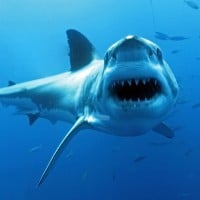 The great white shark (Carcharodon carcharias), also known as the white shark, white pointer, or simply great white, is a species of large mackerel shark which can be found in the coastal surface waters of all the major oceans. It is notable for its size, with larger female individuals growing to 6.1 m (20 ft) in length and 1,905–2,268 kg (4,200–5,000 lb) in weight at maturity. However, most are smaller; males measure 3.4 to 4.0 m (11 to 13 ft), and females measure 4.6 to 4.9 m (15 to 16 ft) on average. According to a 2014 study, the lifespan of great white sharks is estimated to be as long as 70 years or more, well above previous estimates, making it one of the longest lived cartilaginous ...read more.
The great white shark (Carcharodon carcharias), also known as the white shark, white pointer, or simply great white, is a species of large mackerel shark which can be found in the coastal surface waters of all the major oceans. It is notable for its size, with larger female individuals growing to 6.1 m (20 ft) in length and 1,905–2,268 kg (4,200–5,000 lb) in weight at maturity. However, most are smaller; males measure 3.4 to 4.0 m (11 to 13 ft), and females measure 4.6 to 4.9 m (15 to 16 ft) on average. According to a 2014 study, the lifespan of great white sharks is estimated to be as long as 70 years or more, well above previous estimates, making it one of the longest lived cartilaginous ...read more. Well, jaguars can swim to some extent. But a massive disadvantage for jaguar, if the battle is in water and it will get crushed by the Great White Shark. On land, Shark loses by default, no competition.
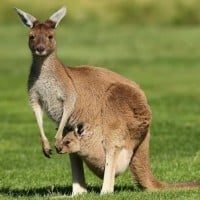 The kangaroo is a marsupial from the family Macropodidae. In common use the term is used to describe the largest species from this family, especially those of the genus Macropus: the red kangaroo, antilopine kangaroo, eastern grey kangaroo, and western grey kangaroo.
The kangaroo is a marsupial from the family Macropodidae. In common use the term is used to describe the largest species from this family, especially those of the genus Macropus: the red kangaroo, antilopine kangaroo, eastern grey kangaroo, and western grey kangaroo. The beaver is a primarily nocturnal, large, semiaquatic rodent. Castor includes two extant species, the North American beaver and Eurasian beaver. Beavers are known for building dams, canals, and lodges.
The beaver is a primarily nocturnal, large, semiaquatic rodent. Castor includes two extant species, the North American beaver and Eurasian beaver. Beavers are known for building dams, canals, and lodges.
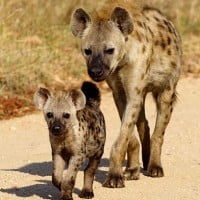 Hyenas or hyaenas are any feliform carnivoran mammals of the family Hyaenidae /haɪˈɛnᵻdiː/. With only four extant species, it is the fifth-smallest biological family in the Carnivora, and one of the smallest in the class Mammalia.
Hyenas or hyaenas are any feliform carnivoran mammals of the family Hyaenidae /haɪˈɛnᵻdiː/. With only four extant species, it is the fifth-smallest biological family in the Carnivora, and one of the smallest in the class Mammalia.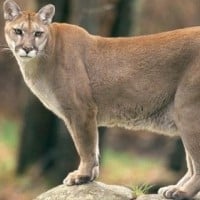 The cougar, also commonly known as the mountain lion, puma, panther, or catamount, is a large felid of the subfamily Felinae native to the Americas.
The cougar, also commonly known as the mountain lion, puma, panther, or catamount, is a large felid of the subfamily Felinae native to the Americas.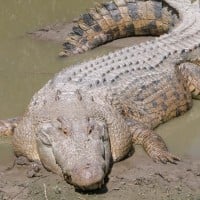 The saltwater crocodile, also known as the estuarine crocodile, Indo-Pacific crocodile, marine crocodile, sea crocodile or informally as saltie, is the largest of all living reptiles, as well as the largest riparian predator in the world.
The saltwater crocodile, also known as the estuarine crocodile, Indo-Pacific crocodile, marine crocodile, sea crocodile or informally as saltie, is the largest of all living reptiles, as well as the largest riparian predator in the world. I almost feel bad for the jaguar